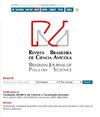Effect of Genetically Modified Organisms Feed Ingredients (Corn And Soybean) in Diet on Egg Production, Egg Broken Rate and Egg Quality in Layers
IF 1.1
4区 农林科学
Q3 AGRICULTURE, DAIRY & ANIMAL SCIENCE
引用次数: 0
Abstract
This study was conducted to examine the effect of feeding genetically modified organisms (GMO) compared with non - GMO diet on performance of layers in terms of egg production, egg broken rate and egg quality in laying hen. One hundred and ninety-two Hy-line brown laying hens were used in the feeding for four weeks. All the birds were randomly assigned into two dietary treatments groups, each with eight replicates (12 hens/ replicate). Significant difference was not found in egg production in layers fed GMO feed in diet compared with the non - GMO treatment. Whereas in terms of egg quality, a significant increase was observed in yolk color and eggshell thickness of layers fed GMO diet compared with layers fed non-GMO diet at 1 st week. Additionally, there was a significant increase in eggshell thickness of layers fed GMO diet compared with layers fed non - GMO diet at 2 nd , and 4 th week. Layers fed GMO diet showed higher egg yolk value compared to the non-GMO diet in 1 st week. However, no significant differences were found in other profiles such as egg quality including egg weight, albumen height, haugh units, shell color, and shell strength from 1 st to 4 th week since layers fed GMO. In conclusion, layers fed GMO diet showed significant improvement in eggshell thickness and yolk color and no significant difference was found in egg production. Layers fed GMO diets may enhance the egg quality, and further research need to be done.饲粮中添加转基因饲料成分(玉米和大豆)对蛋鸡产蛋量、破蛋率和蛋品质的影响
本文章由计算机程序翻译,如有差异,请以英文原文为准。
求助全文
约1分钟内获得全文
求助全文
来源期刊

Brazilian Journal of Poultry Science
农林科学-奶制品与动物科学
CiteScore
1.80
自引率
9.10%
发文量
60
审稿时长
>12 weeks
期刊介绍:
A Revista Brasileira de Ciência Avícola surgiu em 1999 a partir da necessidade que a comunidade científica possuía de um periódico para veiculação e publicação de seus trabalhos, com a publicação de três números anuais.
A Revista conta hoje com um corpo editorial altamente qualificado e com artigos científicos desenvolvidos pelos maiores especialistas da área, o que a cada dia atrai mais leitores em busca de inovação e respaldo técnico.
Devido à credibilidade que conquistou pelos esforços de sus autores, relatores e revisores, a Revista ganhou caráter de coleção, sendo consultada como fonte segura de estudo desenvolvidos na Avicultura.
A partir de 2003 – volume 5 -, a Revista passou a chamar-se Brazilian Journal of Poultry Science, e todos os trabalhos passaram a ser publicados em inglês. No mesmo ano subiu para quatro o número de revistas por volume, ampliando-se assim os trabalhos publicados anualmente.
 求助内容:
求助内容: 应助结果提醒方式:
应助结果提醒方式:


